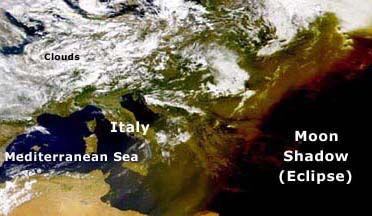
 SeaWiFS Image courtesy of ORBIMAGE Larger Image (142k JPEG) |
This image was taken by the SeaWiFS remote sensing satellite currently in Earth orbit. The image shows the Moon's shadow cast upon eastern Europe. |

 SeaWiFS Image courtesy of ORBIMAGE Larger Image (142k JPEG) |
This image was taken by the SeaWiFS remote sensing satellite currently in Earth orbit. The image shows the Moon's shadow cast upon eastern Europe. |
|
Geography From Space '99 ©2000 National Air and Space Museum |